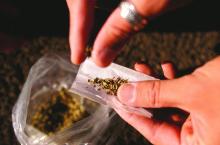User login
A survey has found that 24% of cancer patients at an ambulatory cancer center in Seattle report being active cannabis users.
Respondents said that the legalization of both medical and recreational marijuana increased the likelihood that they’d use the drug, and with most having a strong interest in learning about cannabis during treatment, according to findings published online Sept. 25 in Cancer (doi: 10.1002/cncr.30879).
A total of 926 of 2,737 possible patients – or 34% – filled out the survey.
Twenty-four percent had used cannabis in the last year, and 21% in the last month, with about half smoking cannabis and half consuming edibles.
About half of the respondents reported using cannabis for pain, the top physical symptom for use, with nausea a close second. About 30 to 50% of patients reported using cannabis for nonphysical symptoms such as depression and mood problems. But the researchers noted that the evidence of benefit is mixed at best for all of these symptoms.
“There is a need to better understand methods of cannabis use,” Dr. Pergam said, “to maximize benefit and limit risk because patients are already using a wide variety of products.”
Researchers reported receiving consulting fees from Merck Sharp & Dohme, Optimer/Cubist Pharmaceuticals, Gilead Sciences, and Quartet Health.
A survey has found that 24% of cancer patients at an ambulatory cancer center in Seattle report being active cannabis users.
Respondents said that the legalization of both medical and recreational marijuana increased the likelihood that they’d use the drug, and with most having a strong interest in learning about cannabis during treatment, according to findings published online Sept. 25 in Cancer (doi: 10.1002/cncr.30879).
A total of 926 of 2,737 possible patients – or 34% – filled out the survey.
Twenty-four percent had used cannabis in the last year, and 21% in the last month, with about half smoking cannabis and half consuming edibles.
About half of the respondents reported using cannabis for pain, the top physical symptom for use, with nausea a close second. About 30 to 50% of patients reported using cannabis for nonphysical symptoms such as depression and mood problems. But the researchers noted that the evidence of benefit is mixed at best for all of these symptoms.
“There is a need to better understand methods of cannabis use,” Dr. Pergam said, “to maximize benefit and limit risk because patients are already using a wide variety of products.”
Researchers reported receiving consulting fees from Merck Sharp & Dohme, Optimer/Cubist Pharmaceuticals, Gilead Sciences, and Quartet Health.
A survey has found that 24% of cancer patients at an ambulatory cancer center in Seattle report being active cannabis users.
Respondents said that the legalization of both medical and recreational marijuana increased the likelihood that they’d use the drug, and with most having a strong interest in learning about cannabis during treatment, according to findings published online Sept. 25 in Cancer (doi: 10.1002/cncr.30879).
A total of 926 of 2,737 possible patients – or 34% – filled out the survey.
Twenty-four percent had used cannabis in the last year, and 21% in the last month, with about half smoking cannabis and half consuming edibles.
About half of the respondents reported using cannabis for pain, the top physical symptom for use, with nausea a close second. About 30 to 50% of patients reported using cannabis for nonphysical symptoms such as depression and mood problems. But the researchers noted that the evidence of benefit is mixed at best for all of these symptoms.
“There is a need to better understand methods of cannabis use,” Dr. Pergam said, “to maximize benefit and limit risk because patients are already using a wide variety of products.”
Researchers reported receiving consulting fees from Merck Sharp & Dohme, Optimer/Cubist Pharmaceuticals, Gilead Sciences, and Quartet Health.
FROM CANCER
Key clinical point:
Major finding: Twenty-four percent of patients reported using cannabis in the past year, mostly for pain and nausea.
Data source: A survey of patients at an ambulatory cancer center in Seattle, where cannabis is legal for medical and recreational use.
Disclosures: Researchers reported receiving consulting fees from Merck Sharp & Dohme, Optimer/Cubist Pharmaceuticals, Gilead Sciences, and Quartet Health.

